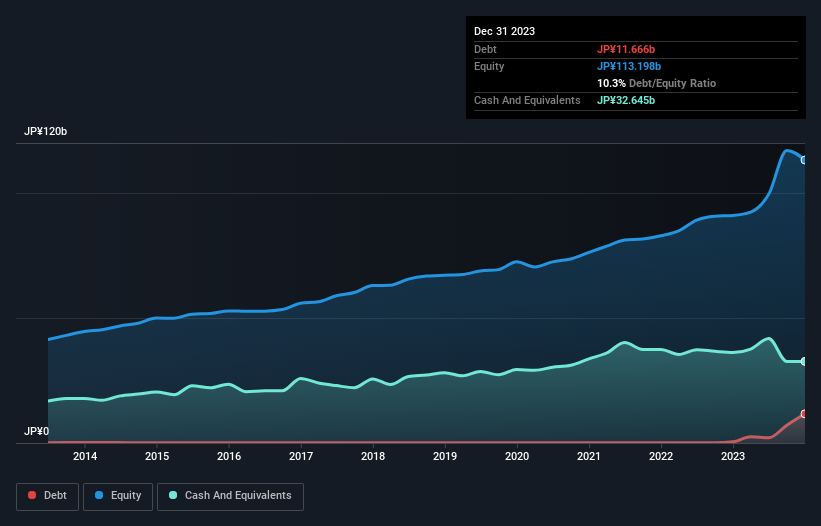
David Iben put it well when he said, 'Volatility is not a risk we care about. What we care about is avoiding the permanent loss of capital.' So it might be obvious that you need to consider debt, when you think about how risky any given stock is, because too much debt can sink a company. Importantly, Nakanishi Inc. (TSE:7716) does carry debt. But should shareholders be worried about its use of debt?
When Is Debt A Problem?
Debt and other liabilities become risky for a business when it cannot easily fulfill those obligations, either with free cash flow or by raising capital at an attractive price. In the worst case scenario, a company can go bankrupt if it cannot pay its creditors. While that is not too common, we often do see indebted companies permanently diluting shareholders because lenders force them to raise capital at a distressed price. Of course, plenty of companies use debt to fund growth, without any negative consequences. The first thing to do when considering how much debt a business uses is to look at its cash and debt together.
Check out our latest analysis for Nakanishi
How Much Debt Does Nakanishi Carry?
As you can see below, at the end of December 2023, Nakanishi had JP¥11.7b of debt, up from JP¥479.0m a year ago. Click the image for more detail. However, its balance sheet shows it holds JP¥32.6b in cash, so it actually has JP¥21.0b net cash.

A Look At Nakanishi's Liabilities
Zooming in on the latest balance sheet data, we can see that Nakanishi had liabilities of JP¥21.5b due within 12 months and liabilities of JP¥6.02b due beyond that. On the other hand, it had cash of JP¥32.6b and JP¥8.38b worth of receivables due within a year. So it actually has JP¥13.5b more liquid assets than total liabilities.
This short term liquidity is a sign that Nakanishi could probably pay off its debt with ease, as its balance sheet is far from stretched. Succinctly put, Nakanishi boasts net cash, so it's fair to say it does not have a heavy debt load!
On the other hand, Nakanishi saw its EBIT drop by 7.3% in the last twelve months. If earnings continue to decline at that rate the company may have increasing difficulty managing its debt load. The balance sheet is clearly the area to focus on when you are analysing debt. But it is future earnings, more than anything, that will determine Nakanishi's ability to maintain a healthy balance sheet going forward. So if you're focused on the future you can check out this free report showing analyst profit forecasts.
Finally, a business needs free cash flow to pay off debt; accounting profits just don't cut it. Nakanishi may have net cash on the balance sheet, but it is still interesting to look at how well the business converts its earnings before interest and tax (EBIT) to free cash flow, because that will influence both its need for, and its capacity to manage debt. In the last three years, Nakanishi's free cash flow amounted to 37% of its EBIT, less than we'd expect. That weak cash conversion makes it more difficult to handle indebtedness.
Summing Up
While it is always sensible to investigate a company's debt, in this case Nakanishi has JP¥21.0b in net cash and a decent-looking balance sheet. So we are not troubled with Nakanishi's debt use. When analysing debt levels, the balance sheet is the obvious place to start. However, not all investment risk resides within the balance sheet - far from it. For example Nakanishi has 3 warning signs (and 2 which are significant) we think you should know about.
If, after all that, you're more interested in a fast growing company with a rock-solid balance sheet, then check out our list of net cash growth stocks without delay.
Valuation is complex, but we're here to simplify it.
Discover if Nakanishi might be undervalued or overvalued with our detailed analysis, featuring fair value estimates, potential risks, dividends, insider trades, and its financial condition.
Access Free AnalysisHave feedback on this article? Concerned about the content? Get in touch with us directly. Alternatively, email editorial-team (at) simplywallst.com.
This article by Simply Wall St is general in nature. We provide commentary based on historical data and analyst forecasts only using an unbiased methodology and our articles are not intended to be financial advice. It does not constitute a recommendation to buy or sell any stock, and does not take account of your objectives, or your financial situation. We aim to bring you long-term focused analysis driven by fundamental data. Note that our analysis may not factor in the latest price-sensitive company announcements or qualitative material. Simply Wall St has no position in any stocks mentioned.
About TSE:7716
Nakanishi
Manufactures and sells dental, surgical, and general industrial products worldwide.
Excellent balance sheet established dividend payer.


